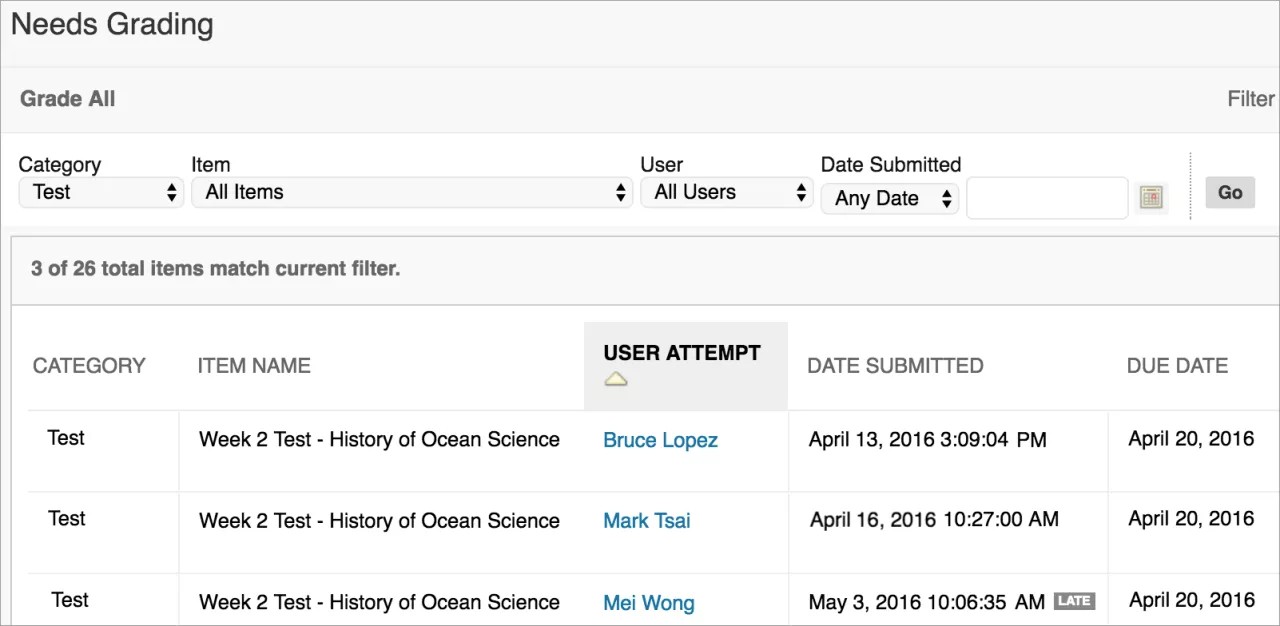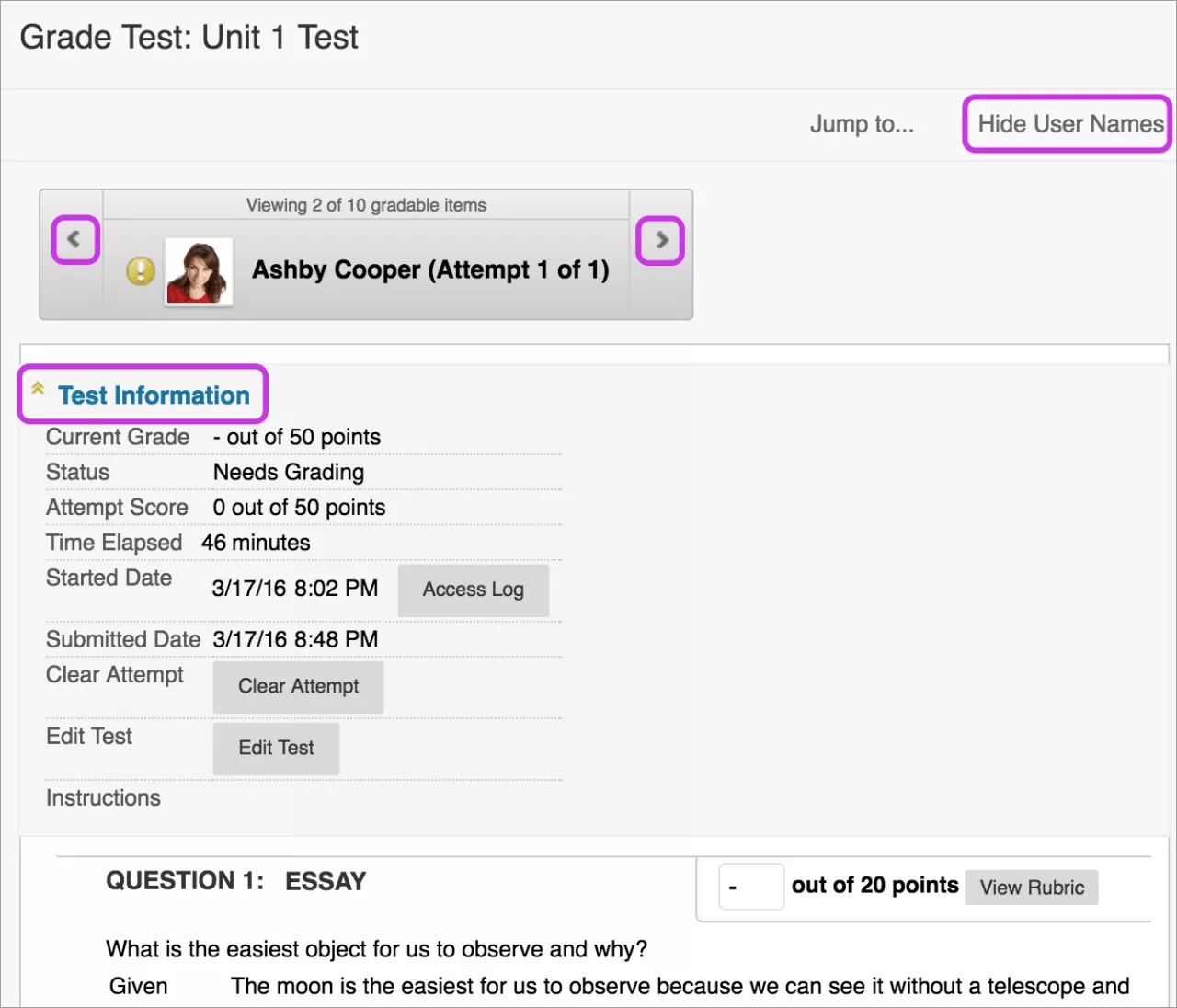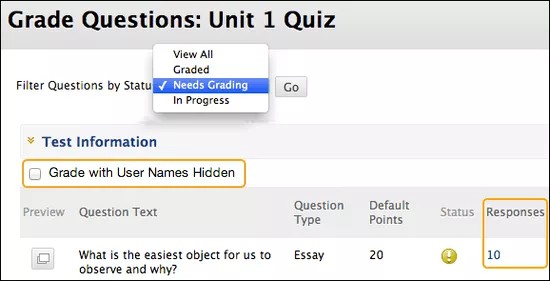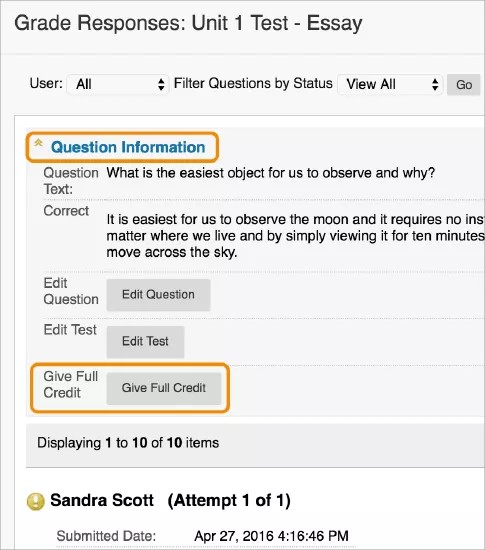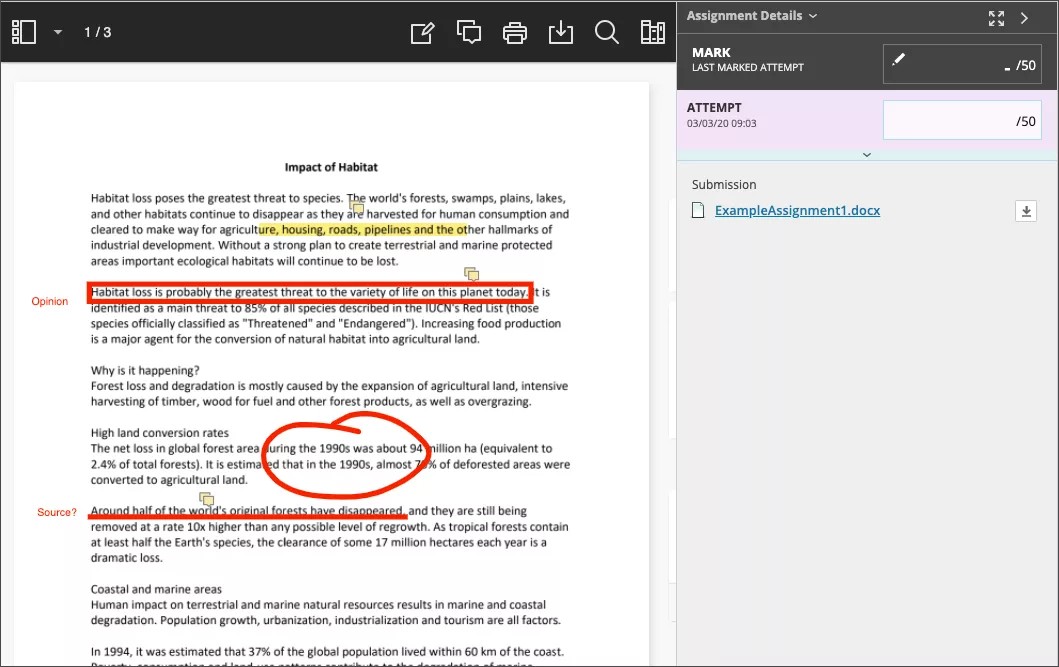Access tests to grade
You access tests that need grading on the Needs Grading page or in the Grade Center.
A Grade Center column is created automatically for each test you create and link in your course. A test that has been submitted, but not graded, is indicated with the Needs Grading icon. Although the system scores many question types, you must grade some questions manually such as Essays, Short Answer, and File Response.
You have the options to grade tests anonymously, to grade all responses to a specific question, and to give full credit for all responses to a question. You can also delete questions from a test or clear a test attempt to allow a student to retake a test.
Send reminders about missing coursework
You can send email reminders from Grade Center columns to students and members of groups who have missing coursework. Students receive a system-generated email that lists the course, coursework, and the due date if you assigned one.
Assign test grades on the Needs Grading page
For courses with many enrolled students and gradable items, the Needs Grading page can help you determine which tests need grading first.
Tests in progress don't appear on the Needs Grading page.
For example, you can sort by the due date so that your final tests are graded before your institution's deadline. If you have a designated turnaround schedule set for all gradable items, you can customize the view of items with a Needs Grading status. You can sort and filter the list and grade the most urgent tests first.
Control Panel > Grade Center section > Needs Grading page
More on the Needs Grading page
Assign test grades in the Grade Center
The Grade Center shows all gradable items. The number of items may influence how you organize your time for grading tasks. You may also find it beneficial to view a student's previous grades as you grade.
Access the Grade Center:
- On the Control Panel, expand the Grade Center section.
- Select Full Grade Center or the Tests smart view, if available, to access test attempts.
Grade a single test:
- Locate the cell for a student's test with the Needs Grading icon.
- Access the cell's menu and select Attempt. The Grade Test page appears.
Grade all attempts for one test:
- Access the test column's menu.
- Select Grade Attempts. The Grade Test page appears.
More on assigning grades in the Grade Center
Grade Test page
On the Grade Test page, you can navigate among students and attempts, view rubrics, grade anonymously, and view information about a test.
Expand the Test Information link to view the status, instructions, and pertinent date and times. You can clear a test attempt so that a student can submit the test again. You can also submit a test that is in progress so that you can grade it.
If a test has questions that you need to assign scores for, the test status is Needs Grading and the Attempt Score is 0.
- On the Grade Test page, type a score for each question that isn't graded automatically. You can also change existing scores.
- Optionally, if you associated a rubric with Essay, Short Answer, or File Response questions, select View Rubric to grade the question with the rubric.
- Optionally, add Response Feedback specific to the individual question. If you want your feedback to show for individual questions such as Essays, select that option on the Questions Settings page. Though a Response Feedback text box displays by default, students won't see any feedback you add unless you select the option. You can't provide individual feedback for answers to True/False, Ordering, and Matching questions.
- Optionally, type comments in the Feedback to Learner box.
- Optionally, type comments in the Grading Notes box. This text is not seen by students.
- Select Save and Exit to return to the Full Grade Center, the Needs Grading page, or the Grade Details page, based on where grading began.
-OR-
Select Save and Next to display the next student, if available.
-OR-
Use the arrows to navigate to the previous or next student, if available.
If you allowed multiple attempts for a test, a student's grade isn't released until you have graded all of the attempts.
Add feedback recordings
You can embed an audio or video recording of your feedback in the editor as you grade attempts. The recording option appears in the feedback editor for most graded items in your course. Students watch or listen to your feedback alongside any text you include.
More on adding audio/video feedback
Grade tests with student names hidden
When you grade tests, you have can hide user names any time during the grading process to eliminate grading bias for high-stakes tests.
Grading anonymously adds another layer of fairness and impartiality. You won't know who made the submission, so you aren't unduly influenced by a student's previous performance, class participation, conflicts, race, gender, or perceived student aptitude. This practice can also contribute to the student-instructor relationship because students are assured that grading was unbiased.
When you grade anonymously, all identifying information is hidden and test attempts appear in random order. Each student is assigned a number, such as Student 8.
Access the Needs Grading page:
- Access a test attempt's menu.
- Select Grade with User Names Hidden. The Grade Test page appears.
Access the Grade Center:
- Access the test column heading's menu.
- Select Grade with User Names Hidden. The Grade Test page appears.
Start from the Grade Test page:
- Select Hide User Names.
- Select OK. If grading was in progress, any unsaved changes to the open attempt are lost. The Grade Test page refreshes, a new attempt appears, and all identifying information is hidden.
Grade tests by question
For each test, you can choose to grade all responses to a specific question. You can move through submissions, and view and score the same question for each student. You can save time as you concentrate only on the answers submitted for one question. You can see how all students responded, and provide immediate feedback about how the group performed on that particular question. Also, you can grade by question when you want to revisit a question that requires a score adjustment for all or many students.
At the same time, you can grade questions with student names hidden. All test attempts remain in Needs Grading status until you've graded all of the responses for all of the questions.
- In the Grade Center, access a test column's menu and select Grade Questions.
-OR-
On the Needs Grading page, access a test's menu and select Grade by Question.
- On the Grade Questions page, you can filter the questions by status: Graded, Needs Grading, or In Progress. You may also select the check box for Grade with User Names Hidden if needed.
- For each question, select the number in the Responses column.
- On the Grade Responses page, expand the Question Information link to view the question. If you didn't previously select anonymous grading, select Hide User Names. Select OK in the pop-up window.
- Select Edit next to the score for a student.
- Type a grade in the Score box. Optionally, add Response Feedback specific to the individual question. The feedback box only appears for certain question types, such as Essays. Select Submit.
- Optionally, if you associated a rubric with Essay, Short Answer, or File Response questions, select View Rubric to grade the question with the rubric.
- After grading all student responses, select Back to Questions to return to the Grade Questions page.
Give or remove full credit
You can Give Full Credit for all test submissions for the question you're viewing. Subsequent submissions are given full credit as well. After you give full credit, you can Remove Full Credit to revert to the automatic grade or to a previously assigned manual grade.
- Follow steps 1-3 in the preceding section to access the Grade Responses page.
- Expand the Question Information link to view the question. If you didn't previously select anonymous grading, select Hide User Names. Select OK in the pop-up window.
- Select Give Full Credit to assign full credit for the question -OR- Remove Full Credit.
- Select Back to Questions to return to the Grade Questions page.
Edit, delete, or change the value of questions
On the Test or Survey Canvas, you can add, edit, and delete questions. You can also add question sets or random blocks, reorder questions, and edit a test or survey's information before students make submissions.
After a test has submissions, you can't add a question, modify the number of questions in a question set, or change a random block definition or options.
Even after you deploy a test or survey and students make submissions, you can delete questions. All affected test submissions are regraded and all affected survey results are updated. The question numbers update automatically. If test submissions exist and you delete a question, the question is removed from the test, along with any possible points earned. Test attempts are regraded as if the question wasn't included in the test.
Bb Annotate
You can use BB Annotate for inline grading in your courses. Bb Annotate offers a more robust feature set to provide customizable feedback to students. Features include a sidebar summary view, freehand drawing tools, various color selections, and much more.
BB Annotate grading workflow
On the Assignment Submission page, supported file types open in the browser. You can view and annotate these document types in the browser:
- Microsoft® Word (DOC, DOCX)
- Microsoft® PowerPoint®(PPT, PPTX)
- Microsoft® Excel®(XLS, XLSX)
- OpenOffice® Documents (ODS, ODT, ODP)
- Digital Images (JPEG, JPG, PNG, TIF, TIFF, TGA, BMP, HEIC)
- Source code (Java, PY, C, CPP, etc)
- Medical Images (DICOM, DICM, DCM)
- PSD
- RTF
- TXT
- WPD
Office Suite Macros, such as Visual Basic, aren't supported.
Annotation sessions expire after one hour. You'll receive a warning message before your session expires. Your completed annotations, feedback, and files are saved on the page. When you return, you can resume working.
Animated gifs display only the first frame in the pdf viewer for annotation purposes. Download the submission to view the animated gif.
Original formatting and embedded images are preserved. If a student submitted an unsupported file, you're prompted to download it. Assignment submissions created through the editor aren't compatible with inline grading.
Bb Annotate is supported on current versions of Firefox, Chrome, Edge, and Safari.
As part of the responsive design, the menu display changes based on the screen size. On medium and small screens, the Document View settings display the page number you're viewing. Annotation tools are stacked under the View Annotation Tools icon. On small screens, the Content Library is hidden.
Menu options from left to right
- Sidebar: View Thumbnail, Outline, or Annotation views of the submission.
- Pages: Use the arrows to jump to different pages in the submission.
- Pan: Move the submission on the page.
- Zoom and Fit: Zoom in and out of the submission or adjust the view to fit the page, fit the width, or select the best fit.
Annotation tools: Select each tool to view the tool properties.
Your selection for each tool is saved between submissions.
- Drawing, Brush, and Eraser: Draw freehand on the submission with various colors, thickness, and opacity. Select the eraser to remove annotations. You can erase parts of a freehand drawing with the eraser or select the Delete icon to delete the whole drawing.
- Image or Stamp: Choose a preloaded stamp or create your own customized stamp or image to add to the submission.
- Undo: Undo or revert the last thing you did.
- Redo: Repeat the last thing you did.
- Text: Add text directly on the submission. You can move, edit, and change the text and select the font, size, alignment, and color of the text.
- Shapes: Choose Line, Arrow, Rectangle, Ellipse, Polygon, and Polyline. Each shape has its own settings to change the color, width, opacity, and more.
Comment: Provide feedback in comments. Your comments appear in a panel next to the submission. You can make your comments anonymous by selecting the Anonymous button. You only have the option to make anonymous comments if your institution has turned them on.
Students can access the annotated files but won't be able to add annotations in their submissions.
Print or Download: Print or download the submission with the annotations.
A known issue with some browsers' built-in PDF viewer may not display all your annotations. Please view annotated PDFs in a native PDF viewer such as Adobe Acrobat.
- Search: Search the submission for specific text.
Content Library: Create a bank of reusable comments. You can add, edit, delete, and search comments in the library. You can also add a comment directly to the submission page from the menu. Select the plus sign to add a new comment to the Content Library. You can Place comment, Copy to Clipboard, Edit, or Delete content from the library. Type keywords or phrases to search for saved comments.<
The Content Library is only available in SaaS environments.
- Highlighter: Select specific portions of the submission to highlight. As you highlight text on the submission, an additional menu opens. You can highlight, strikethrough, underline, squiggle, or comment on the highlighted section.
Watch a video about Annotate in Blackboard Learn
The following narrated video provides a visual and auditory representation of some of the information included on this page. For a detailed description of what is portrayed in the video, open the video on YouTube, navigate to More actions, and select Open transcript.
Video: Annotate in Blackboard Learn provides a tour of the Annotate tools available for inline grading in your Blackboard Learn courses.

